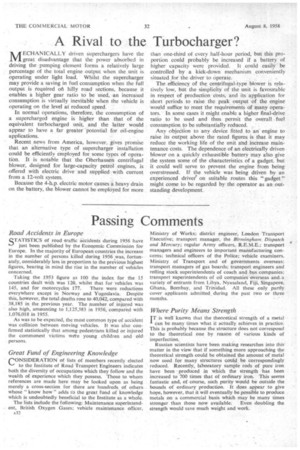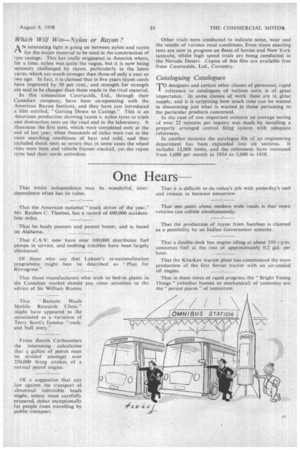Passing Comments
Page 34

Page 35

If you've noticed an error in this article please click here to report it so we can fix it.
Road Accidents in Europe
STATISTICS of road -traffic aecidents during 1956 have just been published by the Economic Commission for Europe. In the majority of European countries the increase in the number of persons killed during 1956 was, fortunately, considerably less in proportion to the previous highest figures, bearing in mind the rise in the number of vehicles concerned.
Taking the 1953 figure as 100 the index for the 15 countries dealt with was 120, whilst that for vehicles was 145, and for motorcycles 177. There were reductions everywhere except in Norway and Yugoslavia. DesPite this, however, the total deaths rose to 40,042, compared with 38,185 in the previous year. The number of injured was also high, amounting to 1;125,383 in 1956, compared with 1,076,018 in 1955.
As was to be expected, the most common type of accident was collision between moving vehicles. It was also confirmed statistically that among pedestrians killed or injured the commonest victims we young children and old. persons.
Great Fund of Engineering Knowledge
CONSIDERATION of lists of members recently elected to the Institute of Road Transport Engineers indicates both the diversity of occupations which they follow and the wealth of experience which they possess. Those to whom references are made here may be looked upon as being merely a cross-section for there are hundreds of others whose "know how adds to the great fund of knowledge which is undoubtedly beneficial to the Institute as a whole. The lists include the following: Maintenance superintendent, British Oxygen Gases; vehicle maintenance officer,
A32 Ministry of Works; district engineer, London Transport Executive; transport manager, the Birmingham Dispatch and Mercury; regular Army officers, R.E.M.E.; transport managers and engineers to important manufacturing concerns; technical officers of the Police; vehicle examiners, Ministry of Transport and of governments overseas; transport managers of gas boards; transport engineers and rolling stock superintendents of coach and bus companies; transport superintendents of oil companies overseas anda variety of entrants from Libya, Nyasaland, Fiji, Singapore, Ghana, Bombay, and Trinidad. All these only partly cover applicants admitted. during the past two or three months.
Where Purity Means Strength
TT is well known that the theoretical strength of a metal A can be many times what it actually achieves in practice. This is probably because the structure does not correspond to the theoretical one by reason of various kinds of imperfection.
Russian scientists have been making researches into this matter in the view that if something more approaching the theoretical strength could be obtained the amount of metal now used for many structures could be correspondingly reduced. Recently, laboratory sample rods of pure iron have been produced in which the strength has been increased to 700 times that of ordinary iron. This seems fantastic and, of course, such purity would be outside the bounds of ordinary production. It does appear to give hope, however, that it will eventually be possible to produce metals on a commercial basis which may be many times stronger than those now available. Even doubling the strength would save much weight and work.
Which Will Win—Nylon or Rayon ?
A N interesting fight is going on between nylon and rayon r-k for the major material to be used in the construction of tyre casings. This has really originated in America where, for a time, nylon was quite the vogue, but it is now being seriously challenged by rayon, particularly in the latest yarns, which are much stronger than those of only a year or two ago. In fact, it is claimed that in five years rayon cords have improved by 50 per cent., and strength for strength are said to be cheaper than those made in the rival material.
In this connection Courtaulds, Ltd., through their Canadian company, have been co-operating with the American Rayon Institute, and they have just introduced a film entitled, " Getting Down to Casings." This is an American production showing rayon v. nylon tyres in trials and destruction tests on the road and in the laboratory. It illustrates the first tests, which were completed only at the end of last year, when thousands of miles were run in the most searching conditions of heat and cold, and they included shock tests so severe that in some cases the wheel rims were bent and vehicle framescracked, yet the rayon tyres had their cords unbroken. Other trials were conducted to indicate noise, wear and the results of various road conditions. Even more exacting tests are now in progress On fleets of lorries and New York taxicabs, whilst high speed trials are being conducted in the Nevada Desert. Copies of this film are available free from Courtaulds, Ltd., Coventry.
Cataloguing Catalogues
TO designers and certain other classes of personnel, rapid 1reference to catalogues of various sorts is of great importance. In some classes of work these are in gi.eat supply, and it is surprising how much time can be wasted in discovering just what is wanted in those pertaining to the particular products concerned.
In the case of one important concern an average saving of over 22 minutes per inquiry was made by installing a properly arranged central filing system with adequate references.
In another instance the catalogue file of an engineering department has been expanded into six sections. It includes 12,000 items, and the references have increased from 1,600 per month in 1954 to 5,000 in 1958.




































































































